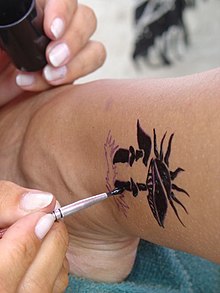This is an old revision of this page, as edited by IntoThinAir (talk | contribs) at 19:29, 3 August 2015 (→Decal-style Temporary Tattoos: replace unsourced content, add source). The present address (URL) is a permanent link to this revision, which may differ significantly from the current revision.
Revision as of 19:29, 3 August 2015 by IntoThinAir (talk | contribs) (→Decal-style Temporary Tattoos: replace unsourced content, add source)(diff) ← Previous revision | Latest revision (diff) | Newer revision → (diff)This article has multiple issues. Please help improve it or discuss these issues on the talk page. (Learn how and when to remove these messages)
|
| It has been suggested that this article be merged with Tattoo. (Discuss) Proposed since July 2015. |
| An editor has nominated this article for deletion. You are welcome to participate in the deletion discussion, which will decide whether or not to retain it.Feel free to improve the article, but do not remove this notice before the discussion is closed. For more information, see the guide to deletion. Find sources: "Temporary tattoo" – news · newspapers · books · scholar · JSTOR%5B%5BWikipedia%3AArticles+for+deletion%2FTemporary+tattoo%5D%5DAFD |

A temporary tattoo is a non-permanent image on the skin resembling a real tattoo. Temporary tattoos can be drawn, painted, or airbrushed as a form of body painting.
Types of Temporary Tattoos
Decal-style Temporary Tattoos
Decal (press-on) temporary tattoos are used to decorate any part of the body. They may last for a day or for more than a week.
Metallic Jewelry Tattoos
New Fashion trend - Foil temporary tattoos, is variation of decal-style temporary tattoos, printed using foil stamping technique instead of using the inks. On the front side, the foil design is printed as a mirror image of in order to be viewed in the right direction once it is applied to the skin. Each metallic tattoo is protected by a transparent protective film.
Air Brush Temporary Tattoos
Although they have become more popular and usually require a greater investment, airbrush temporary tattoos are less likely to achieve the look of a real tattoo, and may not last as long as press-on temporary tattoos. An artist sprays on airbrush tattoos using a stencil with alcohol-based, FDA-approved cosmetic inks. Like decal tattoos, airbrush temporary tattoos also are easily removed with rubbing alcohol or baby oil.
Henna Temporary Tattoos
Another tattoo alternative is henna-based tattoos, which generally contain no additives. Henna is a plant-derived substance which is painted on the skin, staining it a reddish-orange-to-brown color. Because of the semi-permanent nature of henna, they lack the realistic colors typical of decal temporary tattoos. Due to the time-consuming application process, it is a relatively poor option for children. If you do choose henna temporary tattoos, ensure that they are pure henna. Dermatological publications report that allergic reactions to natural henna are very rare and the product is generally considered safe for skin application. Serious problems can occur, however, from the use of henna with certain additives. The FDA and medical journals report that painted black henna temporary tattoos are especially dangerous. Black Henna or Pre-Mixed Henna Temporary Tattoos May Be Harmful - see below for safety information.
Temporary Tattoo Safety
Decal-style Temporary Tattoo Safety
Decal temporary tattoos, when legally sold in the United States, have had their color additives approved by the U.S. Food and Drug Administration (FDA) as cosmetics --- the FDA has determined these colorants are safe for “direct dermal contact.” While the FDA has received some accounts of minor skin irritation, including redness and swelling, from this type of temporary tattoo, the agency has found these symptoms to be “child specific” and not significant enough to support warnings to the public. Unapproved pigments, however, which are sometimes used by non-US manufacturers, can provoke allergic reactions in anyone. Understanding the types of temporary tattoos available to consumers, knowing where they are manufactured, and ensuring they come from a reliable source are keys to determining whether temporary tattoos are safe.
Air Brush Tattoo Safety
The types of airbrush paints manufactured for crafting, creating art or decorating clothing should never be used for tattooing. These paints are not approved for direct contact with skin, and can be allergenic or toxic. Always ask the airbrush tattoo artist what kind of ink he or she is using and whether it meets FDA approval.
Henna Tattoo Safety
The FDA regularly issues warnings to consumers about avoiding any temporary tattoos labeled as black henna or pre-mixed henna as these may contain potentially harmful ingredients including silver nitrate, carmine, pyrogallol, disperse orange dye and chromium. Black henna gets its color from paraphenylenediamine (PPD), a textile dye approved by the FDA for human use only in hair coloring. In Canada, the use of PPD on the skin, including hair dye, is banned. Research has linked these and other ingredients to a range of health problems including allergic reactions, chronic inflammatory reactions, and late-onset allergic reactions to related clothing and hairdressing dyes. They can cause these reactions long after application. Neither black henna nor pre-mixed henna are approved for cosmetic use by the FDA.
See also
External links
![]() Media related to Temporary tattoo at Wikimedia Commons
Media related to Temporary tattoo at Wikimedia Commons
- Picking Henna Kit, Starting with temporary henna tattoos
References
- "Temporary Tattoos, Henna/Mehndi, and "Black Henna"". FDA. Retrieved August 3, 2015.
| Tattoos and tattooing | |||||||||||||||||
|---|---|---|---|---|---|---|---|---|---|---|---|---|---|---|---|---|---|
| Topics | |||||||||||||||||
| Types | |||||||||||||||||
| Process and technique | |||||||||||||||||
| Traditions and practices |
| ||||||||||||||||
| Styles and designs | |||||||||||||||||
| Bodily location | |||||||||||||||||
| Legal status | |||||||||||||||||